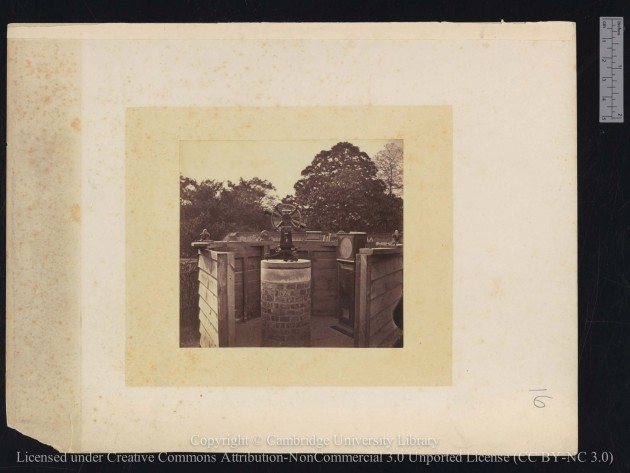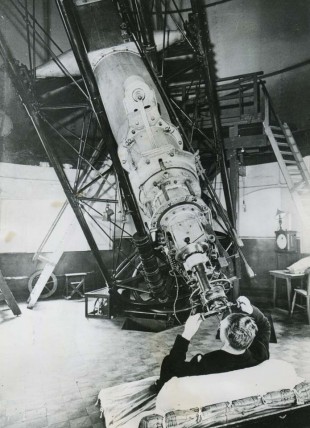…where east meets west
- Home
- Brief History
- The Greenwich Meridian
- Greenwich
(1675–1958) - Herstmonceux
(1948–1990) - Cambridge
(1990–1998) - Outstations (1822–1971)…
- – Chingford (1822–1924)
- – Deal
(1864–1927) - – Abinger
(1923–1957) - – Bristol & Bradford on Avon
(1939–1948) - – Bath
(1939–1949) - – Hartland
(1955–1967) - – Cape of Good Hope
(1959–1971)
- Administration…
- – Funding
- – Governance
- – Inventories
- – Pay
- – Regulations
- – Royal Warrants
- Contemporary Accounts
- People
- Publications
- Science
- Technology
- Telescopes
- Chronometers
- Clocks & Time
- Board of Longitude
- Libraries & Archives
- Visit
- Search
Astronomical Regulator(s): Molyneux
Over the years, the Observatory appears to have owned two astronomical regulators by Molyneux. When or why they were obtained remains unknown despite a recent search of the records and an earlier one made in the 1970s by Derek Howse. Trained by Thomas Earnshaw, Robert Molyneux launched his own business in the 1820s and partnered with his son Henry in 1835.
Both clocks appear in the 1911 and 1926 inventories where they are recorded as:
- Molyneux with flat steel pendulum, and
- Molyneux with wooden pendulum
The first was scrapped in the 1910s or 20s. The second is now in the care of the National Maritime Museum, Object ID: ZBA1725. Its dial is signed Robert Molyneux, London, suggesting that the clock was one of those acquired for the Observatory by John Pond and possibly itemised in the earlier inventories as an Assistant or Journeyman Clock.
Molyneux with wooden pendulum
The Molyneux with wooden pendulum makes its first identifiable appearance in the records in the early 1870s when it was selected as one of the regulators to be sent overseas with the 1874 Transit of Venus Expeditions. Photographed during practice sessions at Greenwich in a hut with one of the small Altazimuths, it was sent to Station C (Rodriguez Island) for the Transit itself, where it was installed in a hut with one of the two Simms 6-inch Equatorials purchased for the expeditions.
It would appear that the clock was definitely already owned by the Observatory. There are two pieces of evidence to support this view:
- Firstly, in 1872 Airy reported to the Visitors that of the ten ‘secondary clocks’ required for the expeditions, one was being furnished by the Observatory. Since the other nine were in the process of being made by Dent (Regulators Dent 2009 to Dent 2017 inclusive) it seems that it was the Molyneux that the Observatory was providing.
- Secondly, The Molyneux was not included in the list of items from the 1874 Transit of Venus Expeditions that were subsequently transferred to the Observatory and recorded in the minutes of the 1878 meeting of the Board of Visitors (ADM190/4/399).

The Regulator at Greenwich alongside one of the Small Altazimuths during preparations for the Transit of Venus in early 1874. Reproduced under the terms of a Creative Commons Attribution-Non-Commercial 3.0 Unported License (CC BY-NC 3.0) courtesy of Cambridge Digital Library (see below)
The clock was also taken on the 1882 Transit of Venus Expedition, the records showing that the movement was taken from the Observatory on 24 January, along with those of other clocks, ‘for the purpose of fitting them for use in the Transit of Venus 1882’. It was returned on 17 April (RGO6/283/615).
The first mention of the Clock in the Introductions to the volumes of Greenwich Observations, seems to come in 1894, (the year after a new inventory was compiled) where it is described as being a mean solar clock having a wooden pendulum and being in the magnetic basement. The 1905 volume is the first to record that it had been moved to Reflex Zenith Tube Room (which was located in the Meridian Building near the Airy Transit Circle).

The Regulator and 28-inch Refactor in the Great Equatorial Building at Greenwich in the 1930s. By this point, one of the two winding holes had been blocked and a large cut-out created for the observation and adjustment of electrical contacts. The case was later lengthened (in the 1950s?) by the addition a new base
The 1926 inventory initially lists it as being in the Cookson Hut, but shows it was later moved (date unknown) to the Dome of the Great Equatorial Building for use with the 28-inch refractor.
When Roy Tucker undertook an audit of the pendulum clocks in the autumn of 1954, the Molyneux regulator could not inititially be found, but by November it transpired that by 1948 it had been transferred to the Solar Department Office and then reconditioned and mounted in the Astrographic Dome in the Meridian Building in 1954. This is partially confirmed by the 1955 Report of the Astronomer Royal (p.21) which states: ‘The Molyneux regulator from Greenwich was reconditioned and returned for use in the Astrographic dome’. At the outbreak of war, the Object Glass of the Astrographic Telescope had been taken to a place of safety and its accompanying regulator, Dent 2009, sent to Abinger for use with the emergency time service. The telescope was brought back into use in 1947/8, staying at Greenwich until 1956/7 when it was moved to Herstmonceux where it was re-erected in dome D in August 1957. It is still in dome D at Herstmonceux today. Howse (1975) records that the Molyneux Regulator was set up in the Drummer’s Hall at Hersmonceux in 1957. The 1963 Report of the Astronomer Royal (p.18) records that the clock was overhauled in the Chronometer Workshop at Herstmonceux.
Molyneux with flat steel pendulum
The first definitive mention of the Molyneux with a flat steel pendulum comes in the 1893 Inventory (RGO39/10/53) where it was listed on 1 November 1894 as being in store with a number of other unused regulators in the lower chronometer room i.e., on the ground floor of the Great Equatorial Building. Listed in 1911 as being in the same location (but now described as ‘South East Bdg., Lower Room’ (RGO39/4/59), its location was later struck out (undated) and the item marked C indicating that it had been condemned.
The 1926 inventory lists it as being in the Shukburgh Dome (Eastern Summerhouse), but this has been struck out (undated) with the comment ‘Useless Scrapped’ (RGO39/5/221). The telescope itself was transferred to the Science Museum in January 1929 (RGO39/5/48).
Image licensing information
The image of the Molyneux Regulator at Greenwich in 1874 is reproduced under the terms of a Creative Commons Attribution-NonCommercial 3.0 Unported License.courtesy of Cambridge Digital Library. The image has been further compressed for this website. The original high resolution images can be viewed here (RGO/6/276/15)
© 2014 – 2026 Graham Dolan
Except where indicated, all text and images are the copyright of Graham Dolan